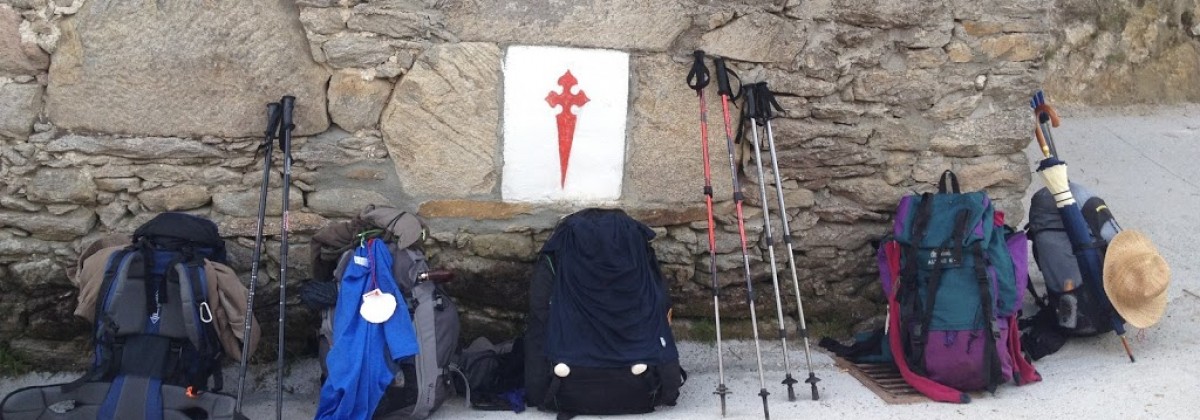as I mentioned in a previous post, there is a strong Celtic vein running through Galicia — climatologically and culturally. the mountains upon which O Cebreiro sits are the first significant vertical obstacle that Atlantic weather systems encounter on their eastward journey, resulting in frequent rain and fog that leave the fields and flora the kind of lush green that reminds you why there are so many different ways to say green in Gaelic languages. the land is hilly and broken up into a patchwork of farms with much more space for grazing animals than in the more eastern provinces. the terrain at the heart of Galicia is hilly, though not quite mountainous necessarily, though mountains divide it from the rest of Spain, contributing somewhat to its isolation. the region is also crossed by numerous rivers, fed by the regular precipitation, winding through dense Atlantic rainforests. similar to Ireland, the ragged coastline is marked with archipelagos, firth-like inlets and high cliffs.
as with my experience in Ireland, the rain came most every day but not in torrential way. throughout our time in Galicia, there was really only one day where it rained persistently and all our rain gear was essential; the rest of the time it drizzled for a bit, or started out fogging in the morning and cleared up relatively quickly. the average rainfall in Santiago in June (one of the driest months and when we visited) is 57mm, while Galway in June sees an average of 72mm. in May, they both have virtually the same of average number of rainfall days and their temperature trends, even, are relatively close though the highs in Galway remain somewhere between 4 and 6 degrees Centigrade cooler.
emigration and economic problems have affected both Galicia and Ireland profoundly; while I’ve read extensively on the Irish diaspora, I had no idea the extent to which the problem might affect another region, or how it might manifest, until I witnessed it in Galicia. as with so many of the small towns we travel through on the Camino, denuded of younger inhabitants, few opportunities beyond life of getting by as a farmer exist in the small communities of Galicia; with the economic crisis Spain currently faces, there are few opportunities even in the cities for young people (though Citroën has a factory for electric cars in Vigo). the lack of opportunities has prompted young men in particular emigrate elsewhere in Spain and to Latin America; this problem is hardly new, however — Fidel Castro’s parents were both of Galician extraction. because of this migration (and a fertility rate of just over one child per Galician woman), the population of Galicia has grown slower than the rest of Spain. moreover, this problem is exacerbated by a gender imbalance favoring women that stems from the tendency of men to migrate. once I read of the nearly two-to-one gender disparity, I noticed it everywhere; women run everything, from bars to stores to farms. the first pub we ate at in Galicia featured a full staff of women and the number of visitor-men significantly outnumbered the number of local-men in the pub.

not unlike Ireland, the native Galician language (Galega) has faced attempts at suppression by the nearby dominant language (Spanish). for four centuries, Spanish was the only official language in Galicia; eventually it fell out of daily use in urban areas but now it is the primary language of instruction. efforts to bring it back into popular usage among Galicians seem to have met with more success than in Ireland; the 2001 census found that 99 percent of Galicians understood Galega, 91 percent could speak it, 68 percent could read it, and 57 percent could write it — the latter two percentages up significantly from a decade earlier (the Franco regime forbid the teaching of Galego). it just barely makes it onto the list of 150 most-spoken languages in the world.
one last similarity is the music; apart from the festival performance we saw in Belorado, we didn’t hear or witness much live music in Spain. granted, we weren’t ones for going out late — much less late for Spain — given our propensity for awaking silly early to get walking before the worst of the heat (and to ensure securing beds on the nights we stayed in the albergues). but in Galicia, we saw more traditional dress and heard a tiny bit more traditional music. as with other Celtic peoples, the traditional music of Galicia features bagpipes called gaita. maybe it’s just through the hazy lens of passed time, but I recall the music featuring the gaita as not unlike what I heard in Ireland, though certainly with its own flavor. as we came down towards the plaza in front of the Catedral in Santiago, a young busker was playing gaita under the final archway, sending the familiar yet distinct music echoing out into the plaza. it was spectacularly atmospheric and I cannot think of a more appropriate way to reach our long-sought destination.


